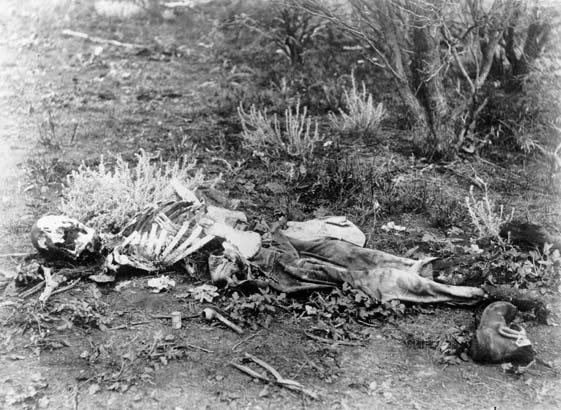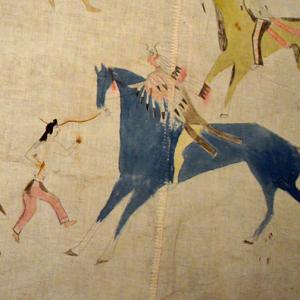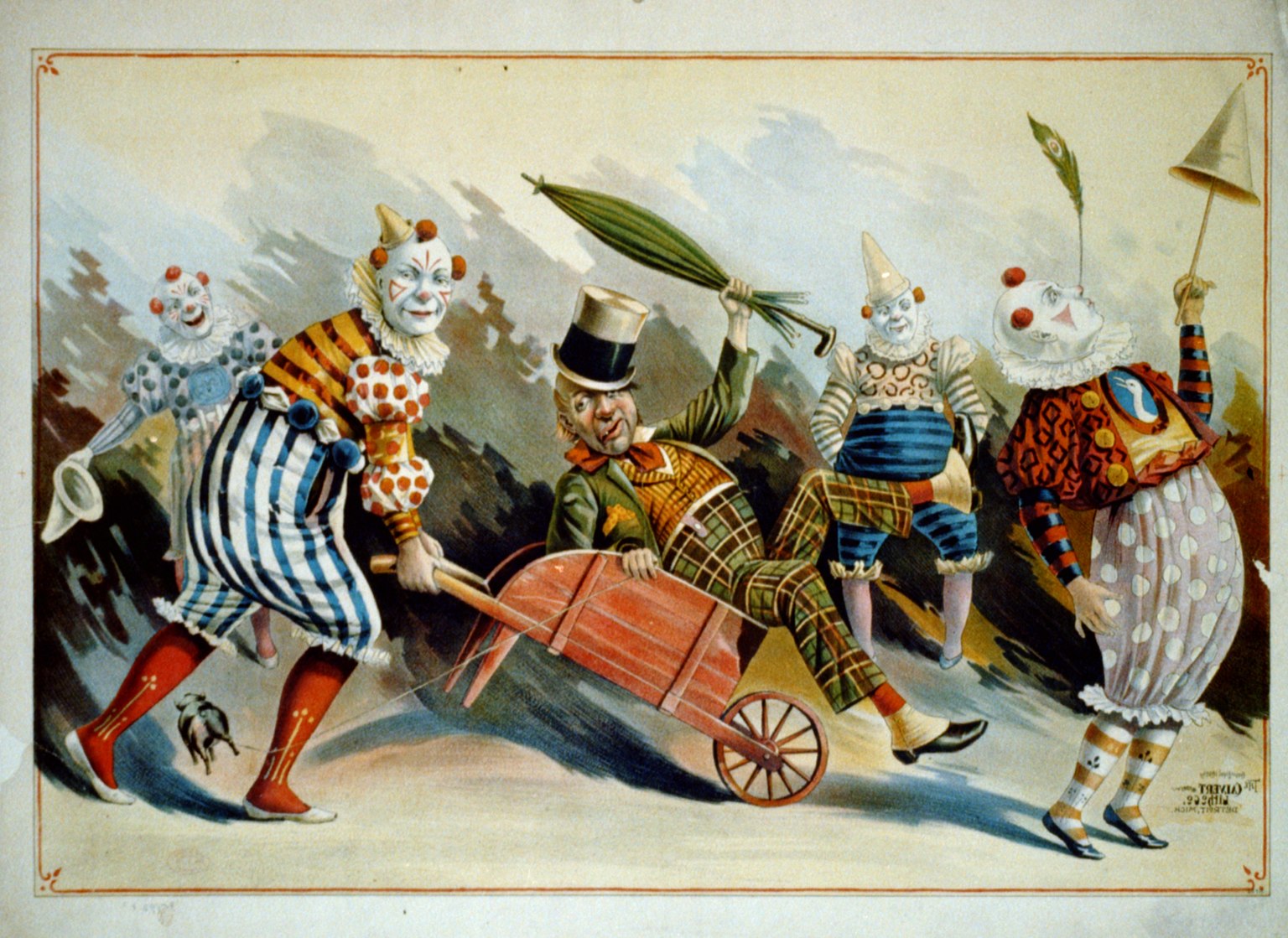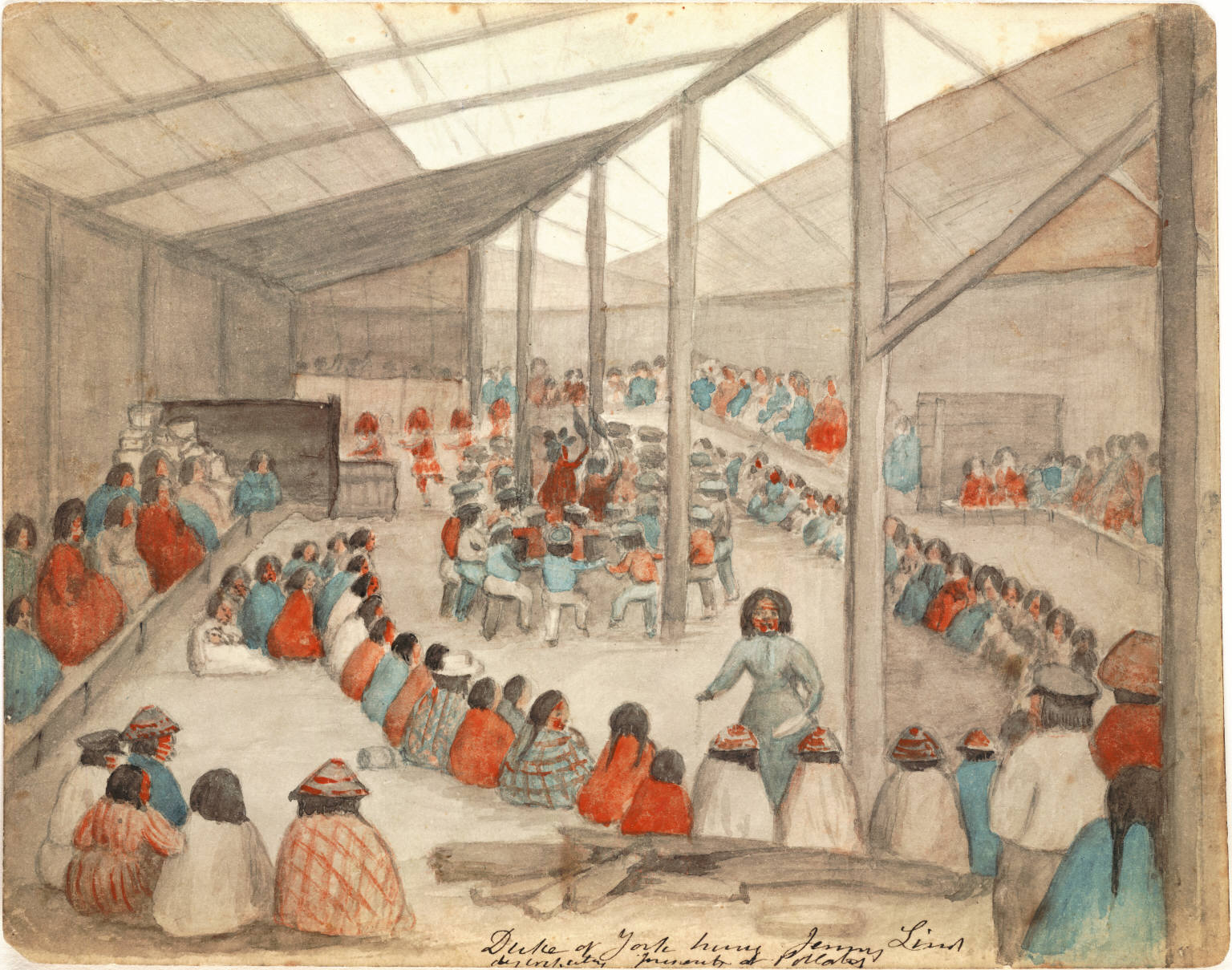|
Clown Society
Clown society is a term used in anthropology and sociology for an organization of comedic entertainers (or "clowns") who have a formalized role in a culture or society. Description and function Sometimes clown societies have a sacred role, to represent a trickster character in religious ceremonies. Other times the purpose served by members of a clown society is only to parody excessive seriousness, or to deflate pomposity. In the sense of how clowns function in their culture: * A clown shows what is wrong with the ordinary way of doing things. * A clown shows how to do ordinary things the "wrong way". By doing ordinary things "the wrong way" the clown reveals what would otherwise be perceived as the serious or true state of things in a different fashion. Members of a clown society may dress in a special costume reserved for clowns, which is often a ridiculously extreme or improper form of normal dress. Some members paint their body with horizontal black and white stripes, which ... [...More Info...] [...Related Items...] OR: [Wikipedia] [Google] [Baidu] |
Anthropology
Anthropology is the scientific study of humanity, concerned with human behavior, human biology, cultures, society, societies, and linguistics, in both the present and past, including archaic humans. Social anthropology studies patterns of behaviour, while cultural anthropology studies cultural meaning, including norms and values. The term sociocultural anthropology is commonly used today. Linguistic anthropology studies how language influences social life. Biological anthropology, Biological (or physical) anthropology studies the biology and evolution of Human evolution, humans and their close primate relatives. Archaeology, often referred to as the "anthropology of the past," explores human activity by examining physical remains. In North America and Asia, it is generally regarded as a branch of anthropology, whereas in Europe, it is considered either an independent discipline or classified under related fields like history and palaeontology. Etymology The abstract noun ''wikt ... [...More Info...] [...Related Items...] OR: [Wikipedia] [Google] [Baidu] |
University Of Oklahoma
The University of Oklahoma (OU) is a Public university, public research university in Norman, Oklahoma, United States. Founded in 1890, it had existed in Oklahoma Territory near Indian Territory for 17 years before the two territories became the state of Oklahoma. In Fall 2024, the university had 34,523 students enrolled, most at its main campus in Norman. Employing nearly 4,000 faculty members, the university offers 174 Bachelor's degree, baccalaureate programs, 199 Master's degree, master's programs, 101 Doctorate, doctoral programs, and 88 certificate programs. The university is Carnegie Classification of Institutions of Higher Education, classified among "R1: Doctoral Universities – Very high research activity", with over $416 million in research expenditures across its three campuses in 2022. Its Norman campus has two prominent museums, the Fred Jones Jr. Museum of Art, specializing in French Impressionism and Native Americans in the United States, Native American artwork, ... [...More Info...] [...Related Items...] OR: [Wikipedia] [Google] [Baidu] |
Juggalo
A juggalo (feminine juggalette, or juggala in Spanish) is a fan of the hip hop group Insane Clown Posse or any other hip hop group signed to Psychopathic Records. Juggalos have developed their own idioms, slang, and characteristics. The Gathering of the Juggalos, alternatively known as just "The Gathering", is a notable annual festival held by juggalos and the artists that they support, which have included rap stars such as Busta Rhymes, Ice Cube, and MC Hammer; over its first eleven events (2000–2010), the festival drew a total attendance of about 107,500 fans, averaging nearly 9,800 per year, with a peak of 20,000 in 2010. History The term juggalo originated during a 1994 live performance by Insane Clown Posse. During the song "The Juggla", Violent J addressed the audience as ''Juggalos'', and the positive response resulted in Violent J and Shaggy 2 Dope using the word thereafter to refer to themselves and their friends, family, and fans, including other Psychop ... [...More Info...] [...Related Items...] OR: [Wikipedia] [Google] [Baidu] |
Tewa
The Tewa are a linguistic group of Pueblo people, Pueblo Native Americans in the United States, Native Americans who speak the Tewa language and share the Pueblo culture. Their homelands are on or near the Rio Grande in New Mexico north of Santa Fe, New Mexico, Santa Fe. They comprise the following communities: * Nambé Pueblo * Pojoaque Pueblo * San Ildefonso Pueblo * Ohkay Owingeh * Santa Clara Pueblo * Tesuque Pueblo The Hopi Tewa, descendants of those who fled the Second Pueblo Revolt of 1680–1692, live on the Hopi Reservation in Arizona, mostly in Tewa Village and Polacca on the First Mesa, Arizona, First Mesa. Other Hopi clans are known to be descendants of Tewa people. Tewa is one of five Tanoan languages spoken by the Pueblo people of New Mexico. Though these five languages are closely related, speakers of one cannot fully understand speakers of another (similar to German and Dutch speakers). The six Tewa-speaking pueblos are Nambe, Pojoaque, San Ildefonso, Ohkay O ... [...More Info...] [...Related Items...] OR: [Wikipedia] [Google] [Baidu] |
Hopi People
The Hopi are Native Americans who primarily live in northeastern Arizona. The majority are enrolled in the Hopi Tribe of Arizona and live on the Hopi Reservation in northeastern Arizona; however, some Hopi people are enrolled in the Colorado River Indian Tribes of the Colorado River Indian Reservation at the border of Arizona and California. The 2010 U.S. census states that about 19,338 US citizens self-identify as being Hopi. The Hopi language belongs to the Uto-Aztecan language family. The primary meaning of the word ''Hopi'' is "behaving one, one who is mannered, civilized, peaceable, polite, who adheres to the Hopi Way." Some sources contrast this to other warring tribes that subsist on plunder.Connelly, John C., "Hopi Social Organization." In Alfonso Ortiz, vol. ed., ''Southwest'', vol. 9, in William C. Sturtevant, ed., ''Handbook of North American Indians'', Washington, D.C.: Smithsonian Institution, 1979: 539–53, p. 551 ''Hopi'' is a concept deeply rooted in the c ... [...More Info...] [...Related Items...] OR: [Wikipedia] [Google] [Baidu] |
Dakota People
The Dakota (pronounced , or ) are a Native Americans in the United States, Native American tribe (Native American), tribe and First Nations in Canada, First Nations band government in North America. They compose two of the three main subcultures of the Sioux people, and are typically divided into the Eastern Dakota and the Western Dakota. The four bands of Eastern Dakota are the , , , and and are sometimes referred to as the Santee ( or ; 'knife' + 'encampment', 'dwells at the place of knife flint'), who reside in the eastern Dakotas, central Minnesota and northern Iowa. They have federally recognized tribes established in several places. The Western Dakota are the Yankton, and the Yanktonai ( and ; "Village-at-the-end" and "Little village-at-the-end"), who reside in the Upper Missouri River area. The Yankton-Yanktonai are collectively also referred to by the endonym ('Those Who Speak Like Men'). They also have distinct federally recognized tribes. In the past the Western Da ... [...More Info...] [...Related Items...] OR: [Wikipedia] [Google] [Baidu] |
Lakota People
The Lakota (; or ) are a Native Americans in the United States, Native American people. Also known as the Teton Sioux (from ), they are one of the three prominent subcultures of the Sioux people, with the Eastern Dakota (Santee) and Western Dakota (). Their current lands are in North Dakota, North and South Dakota. They speak — the Lakota language, the westernmost of three closely related languages that belong to the Siouan languages, Siouan language family. The seven bands or "sub-tribes" of the Lakota are: * (, Burned Thighs) * ("They Scatter Their Own") * (, Without Bows) * (Hunkpapa, "End Village", Camps at the End of the Camp Circle) * (Miniconjou, "Plant Near Water", Planters by the Water) * ("Blackfeet" or "Blackfoot") * (Two Kettles) Notable Lakota persons include (Sitting Bull) from the , (Touch the Clouds) from the Miniconjou; (Black Elk), (Red Cloud), and (Billy Mills), all ; (Crazy Horse) from the and Miniconjou, and (Spotted Tail) from the ... [...More Info...] [...Related Items...] OR: [Wikipedia] [Google] [Baidu] |
Heyoka
The heyoka (, also spelled "haokah," "heyokha") is a type of sacred clown Shamanism, shaman in the culture of the Sioux (Lakota people, Lakota and Dakota people, Dakota people) of the Great Plains of North America. The heyoka is a contrarian, jester, and satire, satirist, who speaks, moves and reacts in an opposite fashion to the people around them. Only those having visions of the thunder beings of the west, the , and who are recognized as such by the community, can take on the ceremonial role of the heyoka. Social role The is thought of as being in charge of above and below, or are more in charge of the dead, instead of the living. This manifests by their not always doing everything like the others. For example, if food is scarce, a may sit around and complain about how full he is; during a baking hot heat wave, a might shiver with cold and put on gloves and cover himself with a thick blanket. Similarly, when it is freezing he might wander around naked, complaining that i ... [...More Info...] [...Related Items...] OR: [Wikipedia] [Google] [Baidu] |
Sacred Clown
__NOTOC__ Ritual clowns, also known as sacred clowns,Cazeneuve (1957) p.254 quotation: are a characteristic feature of the ritual life of many traditional religions,Jones, Lindsay (2005''Encyclopedia of religion'', Volume 6 p.1498 quotation: Cazeneuve (1957) p.242 quotation: and they typically employ scatology and obscenities. Ritual clowning is where comedy and satire originated; in Ancient Greece, ritual clowning, phallic processions and ritual '' aischrologia'' found their literary form in the plays of Aristophanes.Reckford, Kenneth J. (1987''Aristophanes' Old-and-new Comedy: Six essays in perspective''pp.449-51, 461-67 quotation: Two famous examples of ritual clowns in North America are the ''Koyemshis'' (also known as ''Koyemshi'', ''Koyemci'' or ''Mudheads'') and the ''Newekwe'' (also spelled ''Ne'wekwe'' or ''Neweekwe'').Bonvillain, Nancy (200''The Zuni''pp.24-5 French sociologist Jean Cazeneuve is particularly renowned for elucidating the role of ritual clowns; reprisi ... [...More Info...] [...Related Items...] OR: [Wikipedia] [Google] [Baidu] |
Western Culture
Western culture, also known as Western civilization, European civilization, Occidental culture, Western society, or simply the West, refers to the Cultural heritage, internally diverse culture of the Western world. The term "Western" encompasses the social norms, ethical values, Tradition, traditional customs, belief systems, political systems, Cultural artifact, artifacts and technology, technologies primarily rooted in History of Europe, European and History of the Mediterranean region, Mediterranean histories. A broad concept, "Western culture" does not relate to a region with fixed members or geographical confines. It generally refers to the classical era cultures of Ancient Greece and Ancient Rome that expanded across the Mediterranean basin and Europe, and later circulated around the world predominantly through colonization and globalization. Historically, scholars have closely associated the idea of Western culture with the classical era of Greco-Roman antiquity. Howeve ... [...More Info...] [...Related Items...] OR: [Wikipedia] [Google] [Baidu] |
Circus Clown
Circus clowns are a sub-genre of Clown, clowns. They typically perform at circus, circuses and are meant to amuse, entertain and make guests laugh. Traditional types There are traditionally three basic types of clowns that appear in the circus: the whiteface, the auguste and the character. A fourth type, the tramp or hobo clown, is often recognized separately, though similar to the other three types. Absolute definitions of what constitutes each clown type varies, with performers encompassing an extremely wide range of styles, from the classical to the innovative. The whiteface clown The whiteface (or white clown) is the oldest of the clown archetypes. In modern times, when whitefaces perform with other clowns, they usually function as the leader of the group. Whiteface clowns use "clown white" makeup to cover their entire face and neck, with none of the underlying flesh colour showing. Features are then usually painted on in either red or black. The whiteface clown is traditi ... [...More Info...] [...Related Items...] OR: [Wikipedia] [Google] [Baidu] |
Potlatch
A potlatch is a gift-giving feast practiced by Indigenous peoples of the Pacific Northwest Coast of Canada and the United States,Harkin, Michael E., 2001, Potlatch in Anthropology, International Encyclopedia of the Social and Behavioral Sciences, Neil J. Smelser and Paul B. Baltes, eds., vol 17, pp. 11885-11889. Oxford: Pergamon Press. among whom it is traditionally the primary governmental institution, legislative body, and gift economy, economic system.Aldona Jonaitis. ''Chiefly Feasts: The Enduring Kwakiutl Potlatch''. University of Washington Press 1991. . This includes the Heiltsuk Nation, Heiltsuk, Haida people, Haida, Nuxalk Nation, Nuxalk, Tlingit people, Tlingit, Makah people, Makah, Tsimshian, Nuu-chah-nulth people, Nuu-chah-nulth, Kwakwaka'wakw, and Coast Salish peoples, Coast Salish cultures. Potlatches are also a common feature of the peoples of the Interior and of the Subarctic adjoining the Northwest Coast, although mostly without the elaborate ritual and gift-giv ... [...More Info...] [...Related Items...] OR: [Wikipedia] [Google] [Baidu] |










